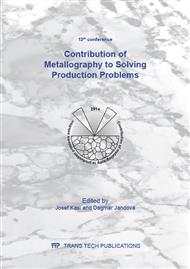p.47
p.59
p.66
p.72
p.79
p.85
p.95
p.102
p.108
The Influence of Oxygen on Mechanical Properties of Ti35Nb6Ta Alloy
Abstract:
The β – Ti alloy with 35 wt. % Nb and 6 wt. % with various oxygen addition (between 0.05 and 0.8 wt. %) has been studied in this work. The alloy was arc melted in a protective atmosphere of helium into water cooled copper crucible. Subsequently the material was thermo-mechanically treated (i.e. homogenized, hot forged, solution treated and cold swaged). Samples of the alloy with the lowest oxygen content were also subjected to aging treatment 450°C for 8 hours. The yield stress Rp0.2, tensile strength (Rm), elongation (A), reduction area (Z) and Young's modulus (E) depending on the oxygen content and on microstructure were studied. Also the microstructure analysis by using the light and electron microscopy has been performed.
Small oxygen addition increases both yield and tensile strength in cold swaged or solution treated conditions. The same can be also said in a lesser extent about Young’s modulus. The decrease in elongation is more distinct for oxygen addition higher than 0.5 wt. %. The oxygen content in this alloy should not exceed this value for practical applications. The increase of strength due to precipitation strengthening leads to significant increase in modulus in comparison with strengthening caused by oxygen addition (when comparing similar strength values achieved).
Info:
Periodical:
Pages:
79-84
Citation:
Online since:
May 2015
Authors:
Keywords:
Price:
Сopyright:
© 2015 Trans Tech Publications Ltd. All Rights Reserved
Share:
Citation:


